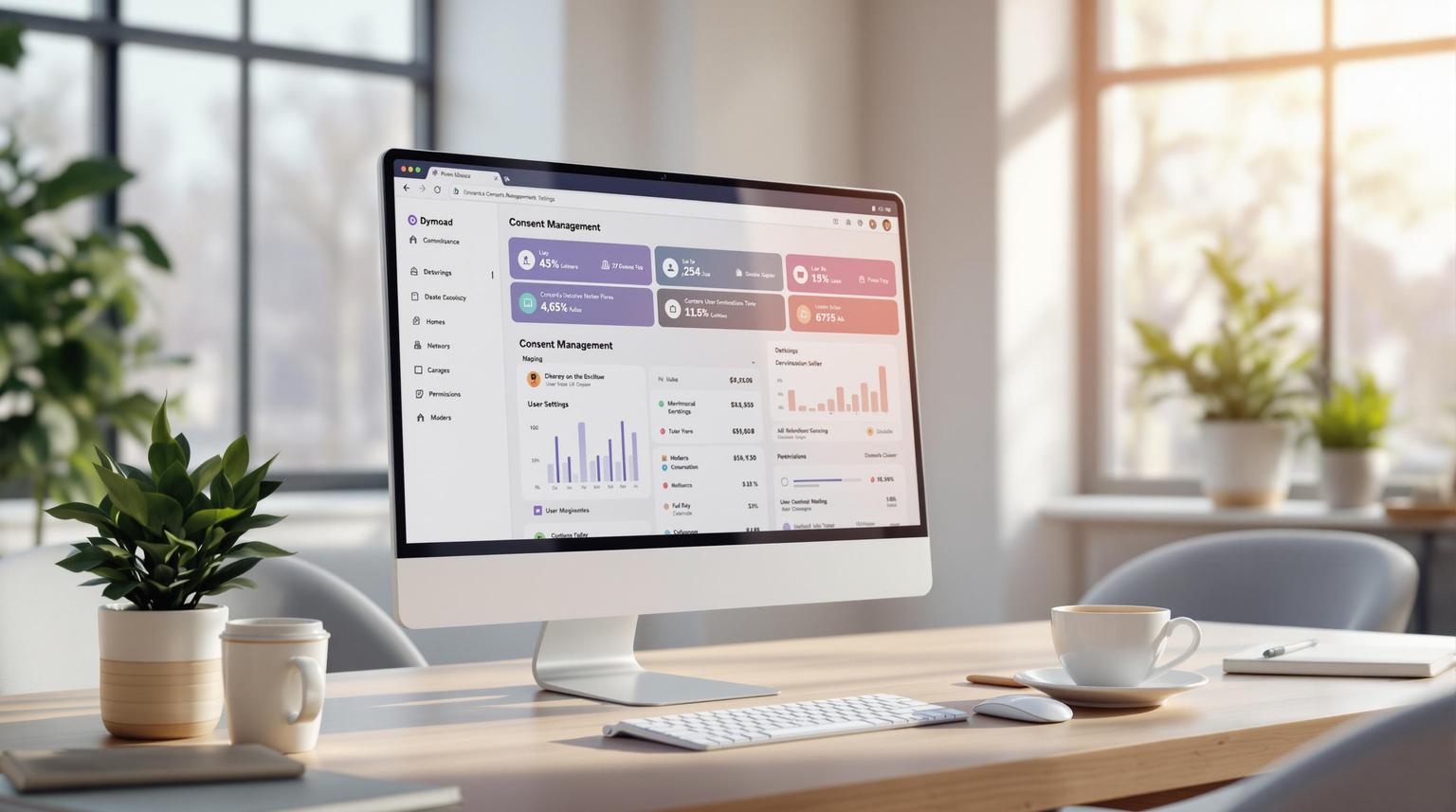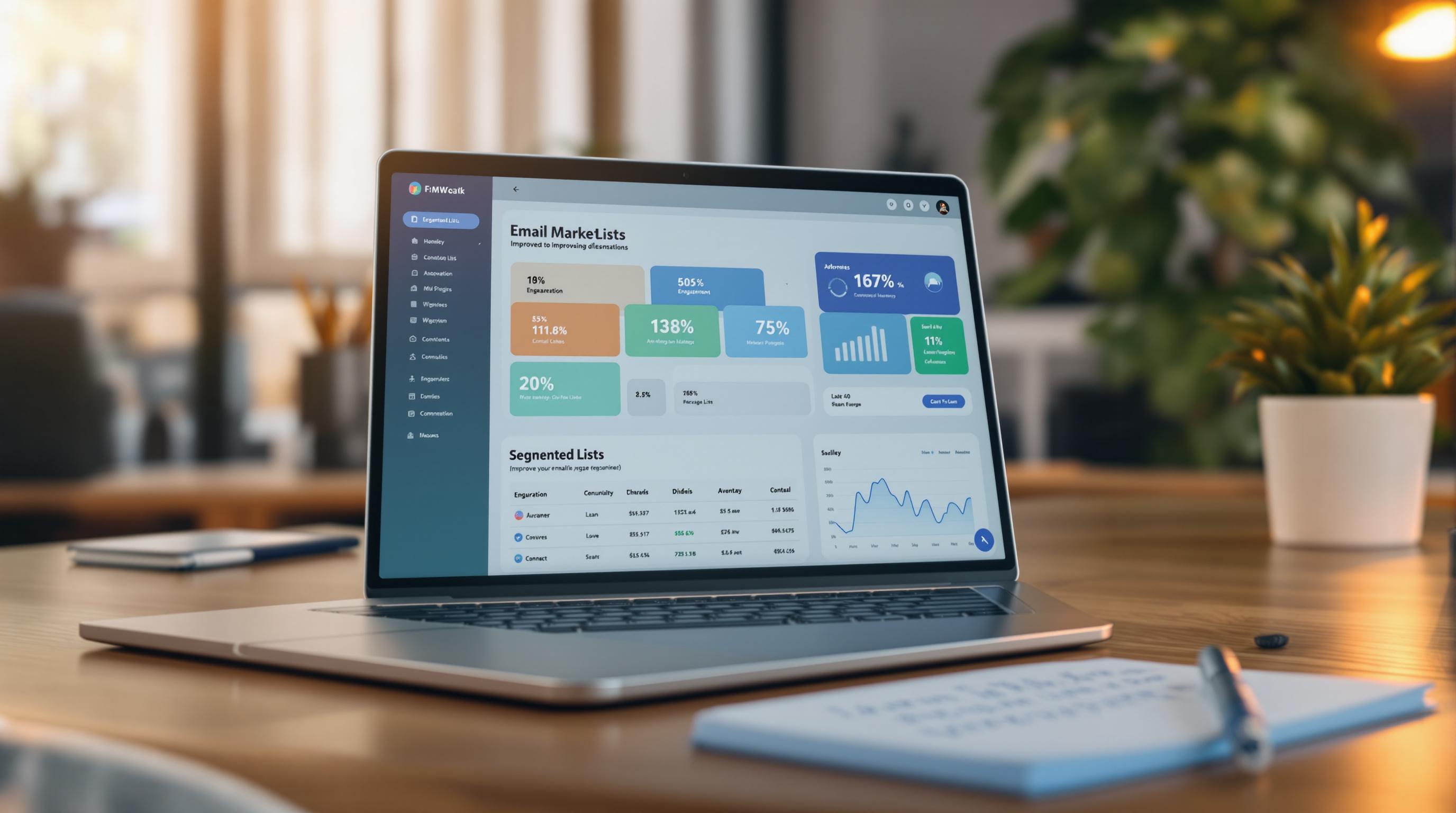Account-Based Marketing (ABM) thrives on close collaboration between sales and marketing teams. To make this work, the right tools are essential. This article highlights 10 of the best ABM tools that help streamline account targeting, engagement tracking, and campaign execution. These platforms enable seamless data sharing, real-time insights, and personalized outreach to high-value accounts. Here's a quick look:
- HubSpot Marketing Hub: Integrated CRM with ABM features like account targeting, engagement tracking, and AI-driven insights.
- Marketo (Adobe): Advanced automation and lead scoring for enterprise-level ABM strategies.
- Salespanel: Real-time visitor tracking, lead intelligence, and CRM integrations.
- LinkedIn Sales Navigator: Professional network insights for targeting decision-makers within accounts.
- Clearbit: Data enrichment and lead scoring to improve targeting accuracy.
- Leadfeeder: Website visitor identification and lead qualification.
- Terminus: Multi-channel ABM campaigns with ad automation and account insights.
- Sendoso: Direct mail and gifting platform for personalized outreach.
- Demandbase: AI-powered account intelligence and engagement tracking.
- Engagio (now part of Demandbase): Engagement scoring and account insights for ABM campaigns.
These tools cater to businesses of all sizes, from small teams to large enterprises, helping improve ROI, align teams, and drive better engagement with target accounts.
4 Account Based Marketing Software Tools For 2022
1. HubSpot Marketing Hub
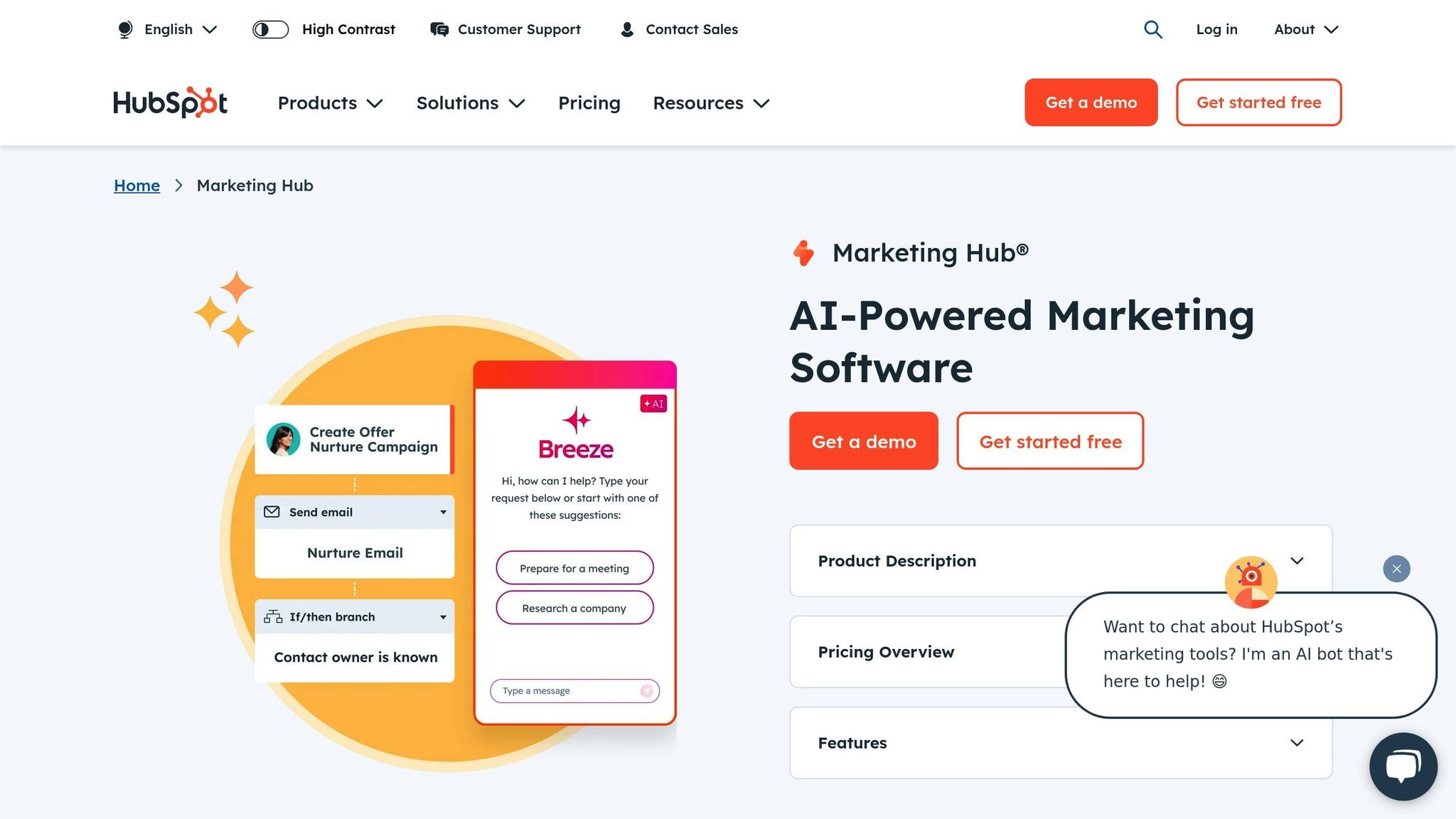
HubSpot Marketing Hub offers a powerful solution for account-based marketing (ABM), uniting sales and marketing teams on a single, integrated platform. As part of HubSpot's CRM, it eliminates the need for multiple tools while delivering a range of ABM-focused features.
ABM-Specific Features Like Account Targeting and Engagement Tracking
HubSpot's ABM tools are designed to help businesses identify and engage high-value accounts. Its Target Account Dashboard provides a clear view of priority accounts, categorizing them into tiers - Tier 1 for top-value accounts and Tier 3 for lower-priority ones .
The platform leverages predictive lead scoring and Ideal Customer Profile (ICP) matching to pinpoint accounts showing strong buying intent. It automatically scores, segments, and ranks accounts based on engagement data. HubSpot's AI also predicts the likelihood of conversion and suggests tailored content to boost engagement.
"ABM is going after a set of defined strategic accounts that are large revenue opportunities for the business." - Dylan Wingrove, Associate Director of Demand Generation, Pacvue
HubSpot tracks key engagement signals - like email opens, ad clicks, and website visits - giving teams real-time insights into account activity. Users can set up automated email sequences that adapt based on engagement levels and create dynamic website content tailored to visitor behavior.
Integration Capabilities With Sales and Marketing Tools
One of HubSpot's standout features is its ability to seamlessly integrate with a wide range of tools. It connects with popular platforms such as Shopify, Mailchimp, and Google Analytics, while also supporting custom API solutions and third-party connectors like Zapier.
For example, in February 2025, Shiv Technolabs showcased how integrating HubSpot CRM with Mailchimp and ActiveCampaign helps track engagement, automate follow-ups, and personalize communication. Mailchimp syncs email campaigns, customer lists, and analytics directly with HubSpot CRM, while ActiveCampaign automates lead nurturing by triggering emails based on user interactions.
HubSpot's Slack integration further enhances collaboration. Teams can push and retrieve data from HubSpot, create Slack channels for specific deals or companies, use Slack commands to pull metrics on target accounts, and share notes between the platforms. This integration streamlines teamwork and simplifies unified campaign tracking.
Collaboration Tools for Data Sharing and Campaign Tracking
HubSpot strengthens sales and marketing collaboration by centralizing customer data and automating tasks. This includes updating customer records, logging interactions, and enabling real-time campaign feedback.
"Ideally, everything you're doing from the sales and marketing sides, you're doing together." - Tim Davidson
Automated workflows improve efficiency by assigning leads, sending follow-up emails, and notifying teams about key account activities. Unified reporting and analytics provide a complete view of account engagement across all touchpoints, ensuring teams stay aligned .
Scalability for Small to Enterprise-Level ABM Efforts
Whether you're a small business or a large enterprise, HubSpot's ABM tools are designed to scale with your needs. These features are included in the Marketing Hub Professional/Enterprise and Sales Hub Professional/Enterprise tiers . For larger organizations, HubSpot Marketing Hub Enterprise offers advanced tools for managing growth, comprehensive reporting, and ABM capabilities.
HubSpot's capacity to handle high volumes is evident in its 2019 statistics: customers sent 22 billion emails and generated 466 million leads using the platform. Getting started with HubSpot's ABM features is simple. Navigate to CRM > Companies and select "See Target Accounts" to define your ICP, create a Target Account List, and automate account categorization based on firmographics and behavior .
2. Marketo (Adobe)
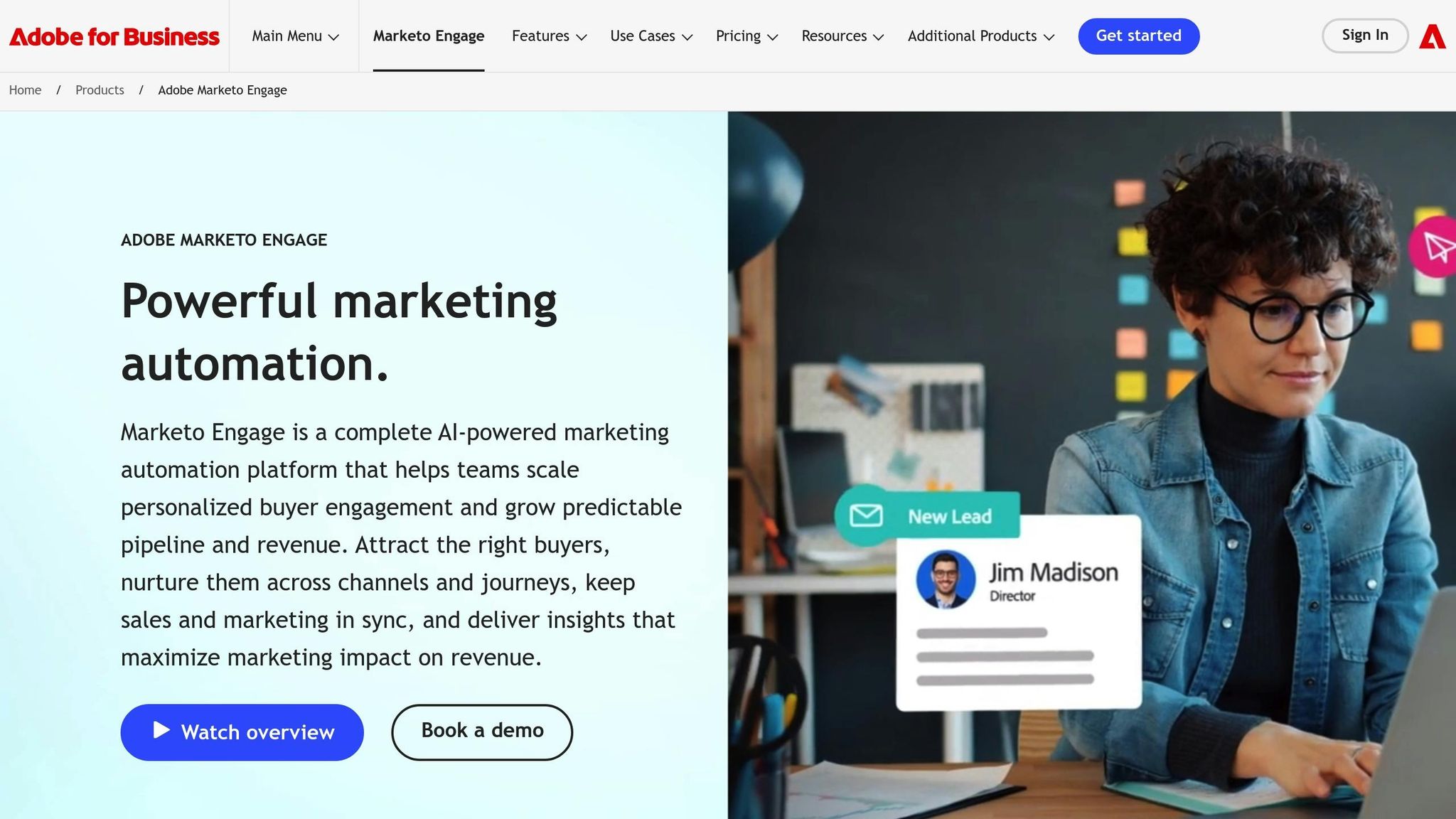
Marketo, now part of Adobe's marketing cloud, brings sales and marketing together with advanced account-based marketing (ABM) strategies. Through its marketing automation platform, Marketo provides enterprise-level ABM solutions, with its Target Account Management (TAM) add-on offering businesses a smarter way to identify, engage, and measure high-value accounts.
ABM-Specific Features Like Account Targeting and Engagement Tracking
Marketo's TAM feature revolves around three main pillars: Target, Engage, and Measure. The Target component helps businesses pinpoint and prioritize valuable accounts. Engage ensures smooth interaction management across multiple touchpoints, while Measure tracks performance and ROI for all ABM efforts. One standout feature is its automated lead-to-account mapping, which groups prospects under the correct company accounts without manual effort, ensuring consistent and accurate targeting.
The Marketo Measure tool offers multi-touch attribution, helping marketers understand how various campaigns, content, and channels contribute to their pipeline and revenue. Additionally, Marketo Engage enriches customer profiles at both individual and account levels, creating a comprehensive view of target accounts. With predictive audience capabilities and segmentation, the platform identifies which accounts are most likely to convert. This targeted approach ensures smooth integration with other tools.
Integration Capabilities With Sales and Marketing Tools
Marketo Engage integrates effortlessly with other applications and data sources. Its CRM integrations synchronize sales and marketing data in real time. This means sales teams gain timely insights into buyer behavior directly within their CRM, ensuring both teams work with the same account intelligence. Beyond CRM, Marketo pairs with tools like Adobe Dynamic Chat and Adobe Marketo Measure to extend its capabilities. It also works with platforms like Alore to enhance sales engagement, streamline outreach, and improve conversions. These integrations create a seamless connection between sales insights and marketing execution.
Collaboration Tools for Data Sharing and Campaign Tracking
Marketo fosters collaboration by unifying data platforms and analytics. Shared metrics and reporting dashboards allow sales and marketing teams to track ABM success together. The platform’s automated lead-to-account mapping ensures that prospects are grouped under the correct company account, enabling coordinated outreach. Workflow automation further reduces friction by updating account records and triggering notifications as needed.
Scalability for Small to Enterprise-Level ABM Efforts
Marketo is designed with enterprise-level businesses in mind, capable of automating complex workflows and handling large data volumes. However, its pricing reflects this focus. Entry-level plans start at $895 per month for basic features, while enterprise-level plans range from $3,195 to $7,195+ per month and require annual contracts. This can make it challenging for smaller businesses with tighter budgets to adopt.
| Business Size | Typical Employee Count | Marketo Suitability | Monthly Cost Range |
|---|---|---|---|
| Small Business | Under 100 employees | Limited suitability | $895+ |
| Growing Enterprise | 500+ employees | Highly suitable | $3,195 - $7,195+ |
| Large Enterprise | 1,000+ employees | Optimal fit | Custom pricing |
For businesses that align with Marketo’s target audience, its automation tools and account management features provide strong support for scaling ABM efforts.
3. Salespanel
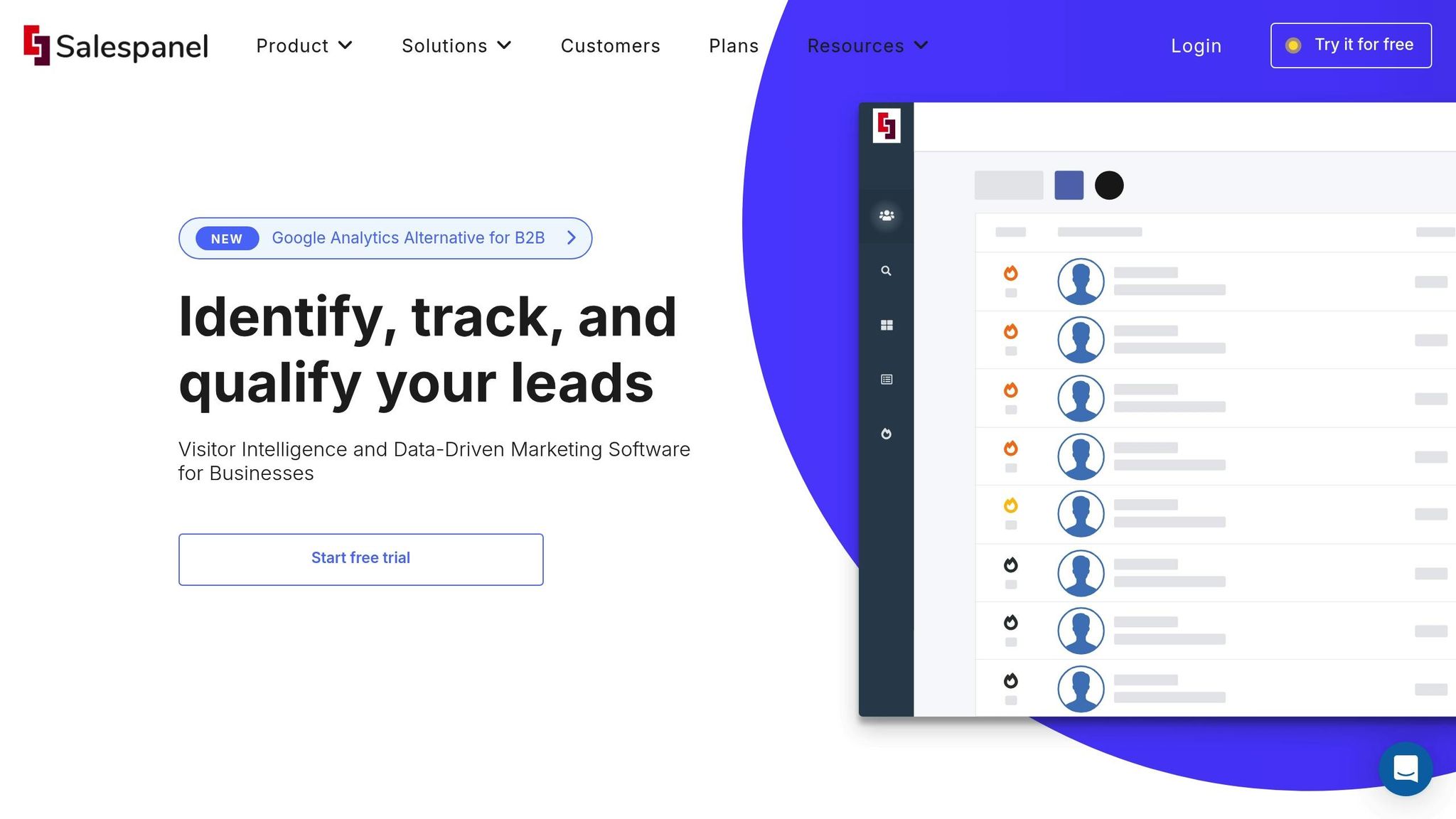
Salespanel is a visitor intelligence platform designed to track inbound accounts at an individual level. Unlike traditional tools that rely on aggregate data, Salespanel focuses on real-time, visitor-specific tracking of website interactions. It monitors both identified leads and anonymous visitors, offering a detailed view that works well with integrated strategies - especially for Account-Based Marketing (ABM) initiatives.
ABM-Specific Features: Account Targeting and Engagement Tracking
One standout feature of Salespanel is its Account Lists, which allows users to upload target account domains and create tailored segments for personalized marketing campaigns. This helps businesses identify key accounts and deliver customized messages based on individual profiles and behavioral insights.
The platform’s visitor intelligence API adds another layer by recognizing visiting companies in real time and providing data such as company size, industry, and location. With tools like website triggers and real-time audience segmentation, users can define criteria for qualified leads - such as a minimum number of page visits or visits to specific pages - and instantly alert team members when these accounts engage with the website. Leads can then be segmented based on profile and activity data, enabling highly targeted messaging. It's worth noting that many organizations need up to six months to fully implement ABM strategies.
Integration Capabilities with Sales and Marketing Tools
Salespanel excels at connecting data from various lead sources to provide immediate sales alerts. It integrates seamlessly with tools like Zapier and webhooks. The platform also works with major CRMs such as Salesforce, Pipedrive, HubSpot, Zoho CRM, Freshsales, Agile CRM, Close CRM, Keap CRM, Sugar CRM, Bitrix24, and Streak CRM. Additionally, it supports marketing automation platforms like Mailchimp, Moosend, and ActiveCampaign. For communication, Salespanel integrates with tools like Slack, Microsoft Teams, Intercom, Drift, Tawk.to, and Olark.
"Using Zapier and Salespanel, marketers can transfer data and lead intelligence to any sales workspace and create workflows for marketing qualified leads."
– Andrew Edelman, Head of Strategic Alliances, Zapier
"With app panels on Pipedrive, we help partner applications update data in the CRM in real-time for deals and contacts. Salespanel uses this functionality to bring dynamic marketing data to sales reps in real-time, helping them close deals more efficiently."
– Krishna Panicker, Chief Product Officer, Pipedrive
Collaboration Tools for Data Sharing and Campaign Tracking
Salespanel’s integrations with tools like Slack and Pipedrive ensure that teams stay updated with real-time lead alerts and CRM data updates. This live visibility into prospect activity enhances collaboration between sales and marketing teams. The platform’s features - such as lead scoring, segmentation, tagging, and detailed visitor attributes - are particularly useful for tracking and qualifying leads.
For email marketing, Salespanel integrates with platforms like Mailchimp and Moosend to track visitors from email campaigns. Qualified leads are then directed to specific lists, creating a smooth workflow between marketing efforts and sales follow-ups. These capabilities make it easier for teams to align their strategies and stay on top of campaign performance.
Scalability for Small to Enterprise-Level ABM Efforts
Salespanel’s versatility allows it to scale for businesses of all sizes. Whether it’s a small company needing basic visitor tracking or a large enterprise managing complex ABM campaigns, the platform adapts to meet varying needs. Its ABM engine not only targets high-value accounts but also enhances customer engagement through personalized website experiences.
Built with first-party data collection in mind, Salespanel provides a practical solution for businesses preparing for a cookieless future. Reviews from 2023 highlight its role in delivering detailed insights into customer journeys and supporting data-driven decision-making. This adaptability makes it a strong choice for businesses looking to elevate their ABM strategies.
4. LinkedIn Sales Navigator
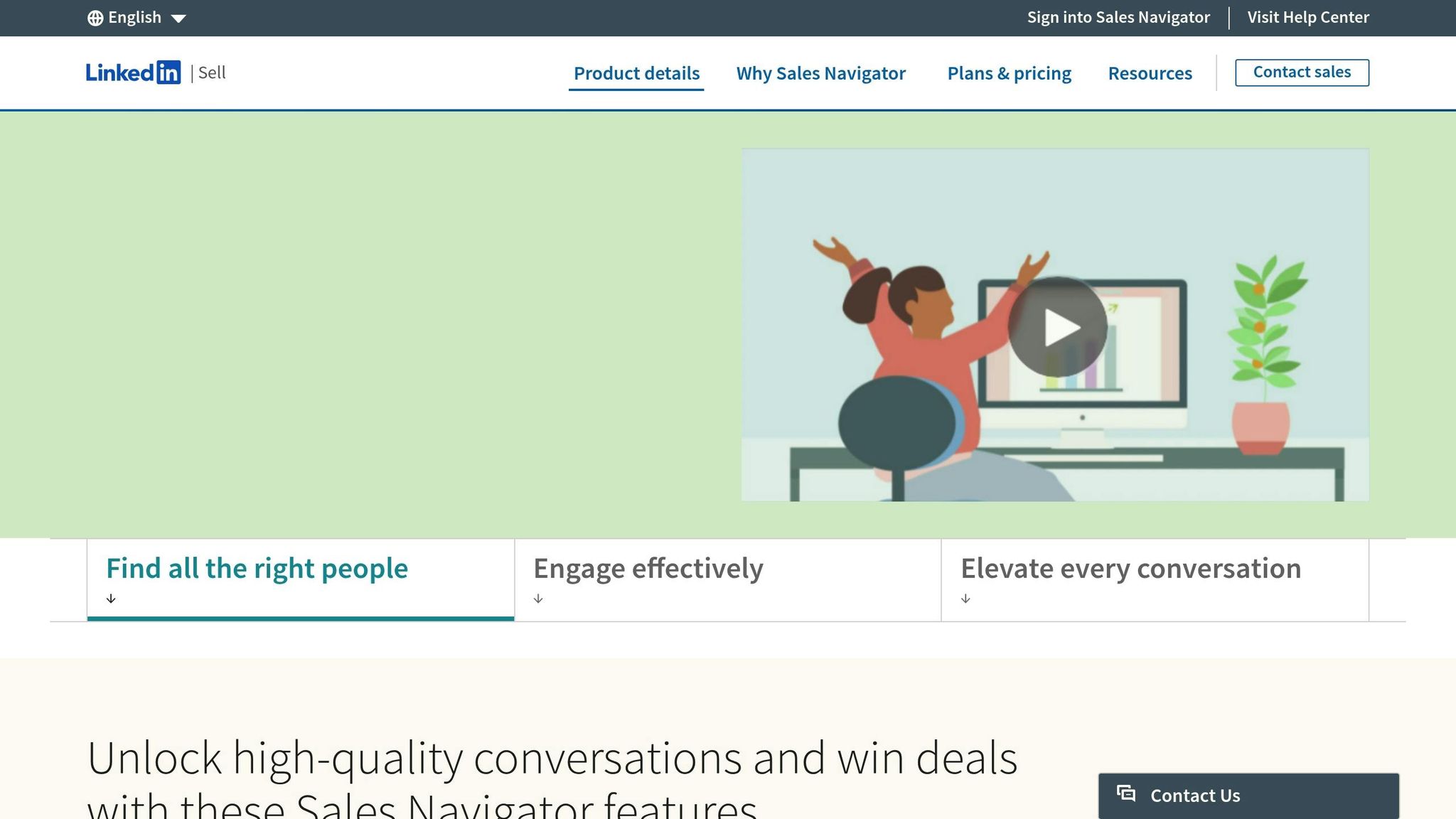
LinkedIn Sales Navigator connects ABM teams to a massive network of over 900 million professionals and 8 million company pages. Designed specifically for B2B sales, this tool offers advanced targeting and engagement features that go well beyond standard LinkedIn capabilities. It’s built to support precise account management and targeted outreach.
ABM-Specific Features: Account Targeting and Engagement Tracking
Sales Navigator stands out by helping teams pinpoint and engage with decision-makers in target accounts. It consolidates insights, making it easier for teams to work together effectively. Real-time updates notify users of critical changes, like job shifts, shared content, or company news [39,44]. This allows sales professionals to prioritize leads and reach out when the timing is just right.
The "Companies" feature in Campaign Manager highlights which organizations are interacting with your paid ads or organic content. Boolean search functionality lets users filter contacts by skills, job titles, or industries. Plus, TeamLink connections make it simple to find mutual connections who can provide warm introductions.
Integration Capabilities with Sales and Marketing Tools
Sales Navigator seamlessly integrates with CRMs like HubSpot, ensuring account data stays unified and easily accessible. Its CRM sync feature simplifies the process of transferring leads and notes into existing systems. Teams can also use Smart Links to share trackable content, monitoring engagement in real time. These integrations foster smoother collaboration between sales and marketing teams, ensuring everyone is working toward the same goals.
Collaboration Tools for Data Sharing and Campaign Tracking
With real-time updates on saved accounts, Sales Navigator keeps everyone on the same page. Key activities like job changes and company news are tracked [39,40], enabling personalized outreach through InMail based on a prospect’s engagement or profile activity [39,43]. Teams can also filter and export company lists to create follow-up campaigns for engaged accounts, while excluding less relevant ones to keep campaigns focused. These tools, combined with flexible pricing, make it a valuable asset for businesses of all sizes.
Scalability for Small to Enterprise-Level ABM Efforts
Sales Navigator offers three pricing tiers to meet the needs of different businesses and ABM strategies.
- Sales Navigator Core: Starting at $79.99 per month (billed annually), this plan is aimed at individuals and small businesses.
- Sales Navigator Advanced: Priced at $139.99 per month, it includes team collaboration tools and advanced analytics.
- Sales Navigator Advanced Plus: Custom enterprise pricing (approximately $1,600 per seat annually) supports larger organizations with comprehensive ABM requirements.
These plans make it easy to scale your ABM efforts, whether you’re a small business or a large enterprise. According to a Forrester study, Sales Navigator delivers an impressive 312% ROI over three years and can pay for itself within six months. Advanced filtering options further improve campaign efficiency by helping teams focus on active prospects while sidelining under-engaged accounts.
In practice, companies like BMC Software have found immense value in the platform. Will Stephen from BMC shared how Sales Navigator helps them better understand their prospects’ priorities by tracking updates, enabling deeper, more meaningful conversations.
"LinkedIn Sales Navigator is a crucial element of an ABM strategy."
- Andrei Zinkevich, Co-founder @Fullfunnel.io
"By seeing updates from prospects, you learn what really matters to them. You're not just talking product – you're talking about their industry and concerns, and it shows you understand them."
- Will Stephen, BMC Software
5. Clearbit
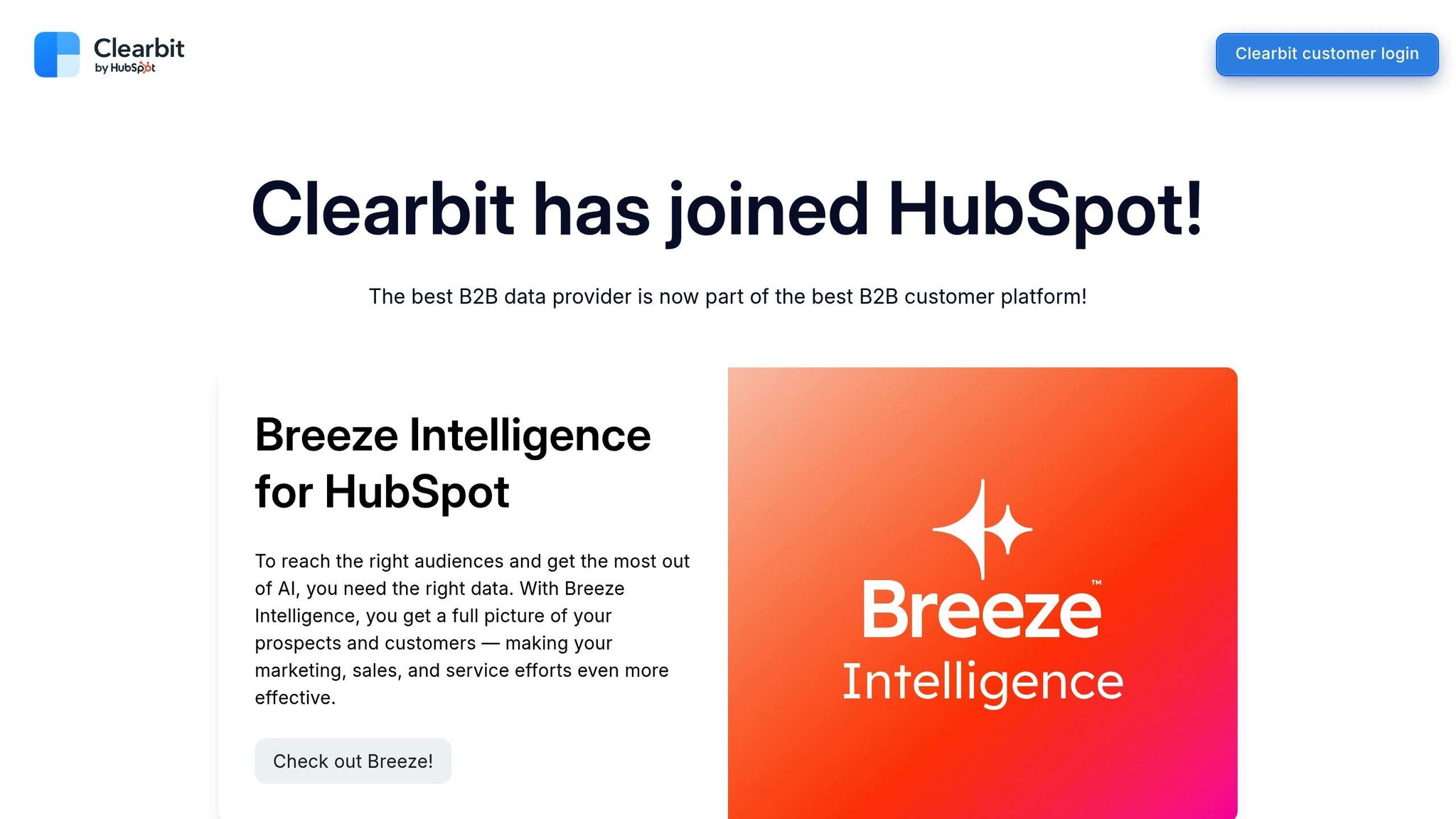
Clearbit is a powerful tool designed to refine and enhance data quality, helping teams execute more precise account-based marketing (ABM) strategies. By delivering accurate company and contact data, Clearbit supports targeted outreach and alignment between sales and marketing efforts. Well-known companies like Segment, Asana, Notion, InVision, and Lattice trust Clearbit to enrich their ABM initiatives, ensuring their campaigns are data-driven and effective.
ABM-Specific Features: Account Targeting and Engagement Tracking
Clearbit offers a range of tools tailored specifically for ABM. Clearbit Prospector allows users to fine-tune their target lists with advanced filters based on firmographics and technographics, ensuring alignment with their ideal customer profile. Meanwhile, Clearbit Reveal identifies and de-anonymizes website visitors, showing which companies they represent .
For example, Chorus.ai used Clearbit's enriched data to develop a focused ABM strategy aimed at sales executives in large, fast-growing tech companies.
Kristen Malkovich, Director of Marketing at Chorus.ai, shared that this approach helped maintain approximately 96% database cleanliness through consistent updates.
Integration Capabilities with Sales and Marketing Tools
Clearbit works seamlessly with popular CRMs like Salesforce and Vtiger, as well as marketing automation tools such as HubSpot, Marketo, and Customer.io. The integration process is quick and efficient: when a lead or account is created or updated, Clearbit pulls data from its extensive network and updates records within seconds. These records are refreshed every 30 days to ensure accuracy.
For Salesforce users, Clearbit's integration automatically enriches CRM records, minimizing manual data entry and enabling teams to create more personalized workflows. This seamless data sharing supports the unified sales and marketing strategies that are vital for ABM success.
Collaboration Tools for Data Sharing and Campaign Tracking
Clearbit fosters collaboration between sales and marketing teams by providing consistently updated records that simplify campaign tracking. Clean, detailed data enhances lead scoring, segmentation, and campaign performance. The platform's integration with tools like Drift offers instant access to firmographic, technographic, and contact details. Additionally, its APIs automate tasks like lead scoring and form optimization, allowing teams to tailor campaigns based on role, company size, or technology stack - all within their existing tools.
Scalability for Small to Enterprise-Level ABM Efforts
Clearbit's pricing starts at approximately $79 per month for its basic Enrichment plan, while Prospector is available at around $799 per month. The platform receives high ratings across review sites, including 4.4/5 on G2, 8.9/10 on TrustRadius, and 4.5/5 on Capterra. Users frequently highlight its ease of use and accuracy in delivering company insights. With its scalable features and strong integrations, Clearbit is a versatile solution for businesses at any stage of their ABM journey.
6. Leadfeeder
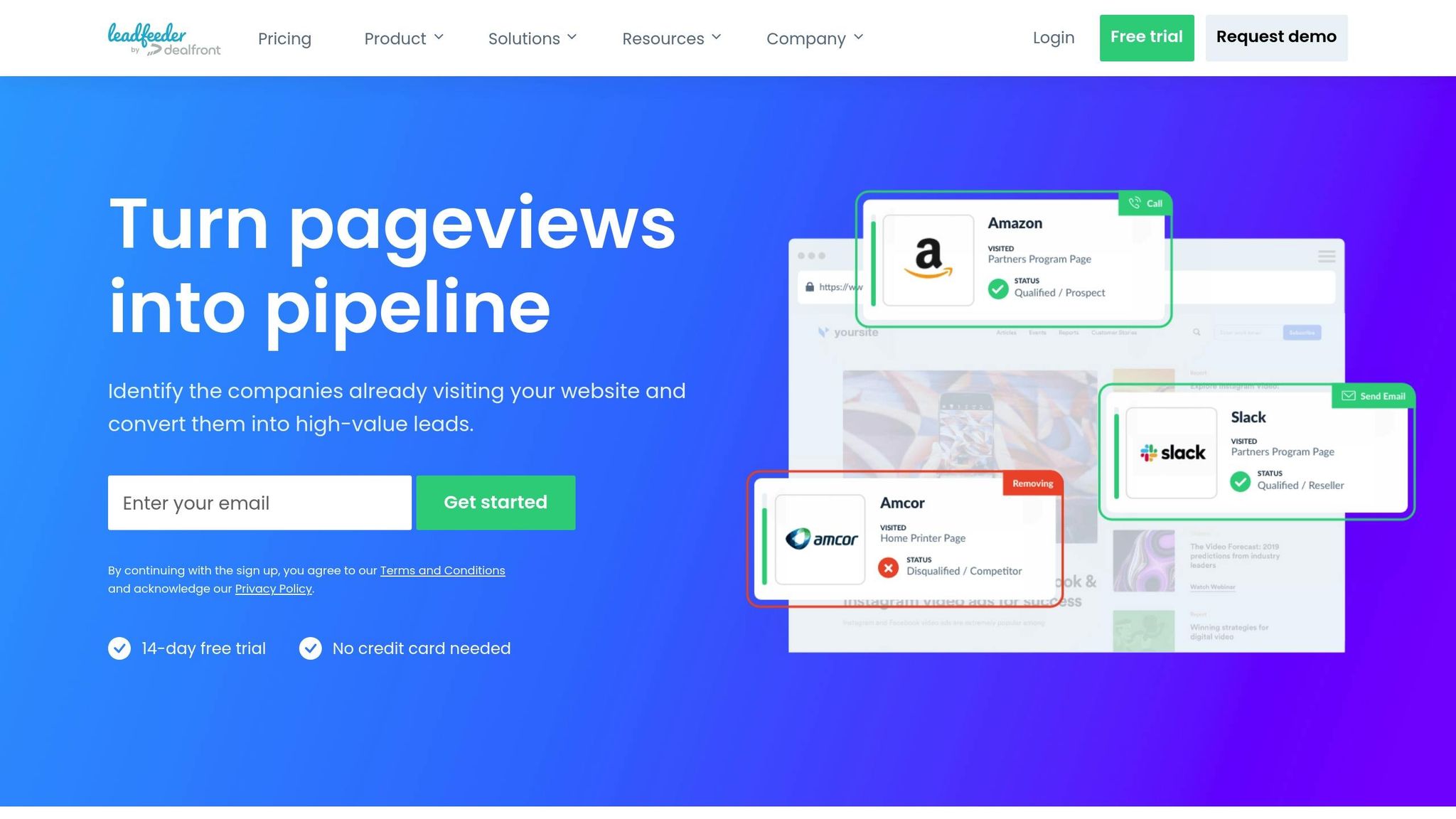
Leadfeeder is all about website visitor identification, giving sales and marketing teams a way to uncover which companies are browsing their site - even if those visitors remain anonymous. This makes it a standout tool for account-based marketing (ABM) strategies, where understanding anonymous traffic can pinpoint high-intent prospects. By turning website analytics into actionable insights, Leadfeeder helps teams zero in on companies already showing interest in their offerings, streamlining efforts and boosting efficiency.
ABM-Specific Features: Account Targeting and Engagement Tracking
Leadfeeder’s strength lies in its ability to pinpoint and monitor company-level website visitors with impressive accuracy. Users can create targeted lead lists and track buying signals, such as specific pages viewed, time spent on the site, and how visitors interact with content. Teams can sync their target account lists directly with Leadfeeder, assign sales development representatives (SDRs) to specific accounts, and get real-time alerts when those companies visit their site.
The platform also uses automatic lead scoring to rank prospects based on their web activity, helping teams focus on the most promising leads. Beyond visitor tracking, Leadfeeder provides detailed engagement data tied to specific accounts, offering insights into intent signals and campaign performance. This data gives teams a clear picture of how well their ABM efforts are working.
A great example of this in action comes from CloudTalk. Using Leadfeeder, they identified 1,000 new prospects each month who visited their site but didn’t sign up for trials. By crafting personalized ABM campaigns targeting the 20 most active visitors, they secured 20 additional company sign-ups for their free trial every month.
Integration Capabilities with Sales and Marketing Tools
Leadfeeder seamlessly integrates with popular CRM and marketing platforms, making collaboration easier across teams. For instance:
- Pipedrive: Automatically creates new deals.
- HubSpot: Fills CRMs with buyer intent data.
- Salesforce: Links leads to existing accounts.
Additionally, it works with Slack and Google Ads, sending alerts when target companies visit and highlighting engaging keywords. For those using Microsoft Dynamics, Leadfeeder identifies which website visitors are already in the CRM, avoiding duplicate efforts and allowing for more tailored follow-ups.
The platform also connects to over 5,000 apps via Zapier, ensuring smooth data flow across tools like spreadsheets and business intelligence software. This extensive integration capability ensures that teams can access and act on insights wherever they work.
Collaboration Tools for Data Sharing and Campaign Tracking
Leadfeeder promotes teamwork by offering shared visibility into prospect behavior and campaign outcomes. It supports LinkedIn retargeting and its own ABM advertising campaigns, providing a centralized view of how prospects engage across channels. Teams can easily access stored data to keep their ABM strategies up to date and adjust them as needed.
"Leadfeeder is a must-have tool for any account-based marketing campaign. Its ability to collect and report on first-party intent data has been critical to helping us align our marketing activities and ensure we are reaching the correct accounts", says An, Growth Marketing Manager at xGrowth.
Leadfeeder’s ability to track traffic sources and content interaction helps teams refine their ABM strategies, leading to stronger connections with high-quality prospects. When paired with Dealfront Sales Intelligence, the platform offers prioritized lead lists complete with company profiles and contact details, ensuring a seamless handoff between marketing and sales.
Scalability for Small to Enterprise-Level ABM Efforts
Leadfeeder offers pricing plans that suit businesses of all sizes.
- Leadfeeder Lite: A free option with basic visitor tracking, seven-day data retention, and identification of up to 100 companies per month - ideal for small businesses experimenting with ABM.
- Premium Plan: Starts at $99 per month and includes unlimited data retention, advanced lead scoring, CRM integration, and Leadfeeder Contacts™. Pricing adjusts based on the number of companies identified.
For international businesses, paid plans begin at $99 per month (billed annually) for up to 50 identified companies, with costs increasing as visitor volume grows. Notably, 9 out of 10 customers praise Leadfeeder’s data quality.
Leadfeeder’s scalability is evident in its success stories. For example, LMCS used visitor data to create targeted lead lists. Their sales team reached out to 75 companies, secured 14 appointments, and sent 12 offers through email campaigns. Similarly, xGrowth leverages Leadfeeder to collect engagement data for each opportunity, helping them track intent signals and measure campaign success across their clients.
sbb-itb-6e7333f
7. Terminus
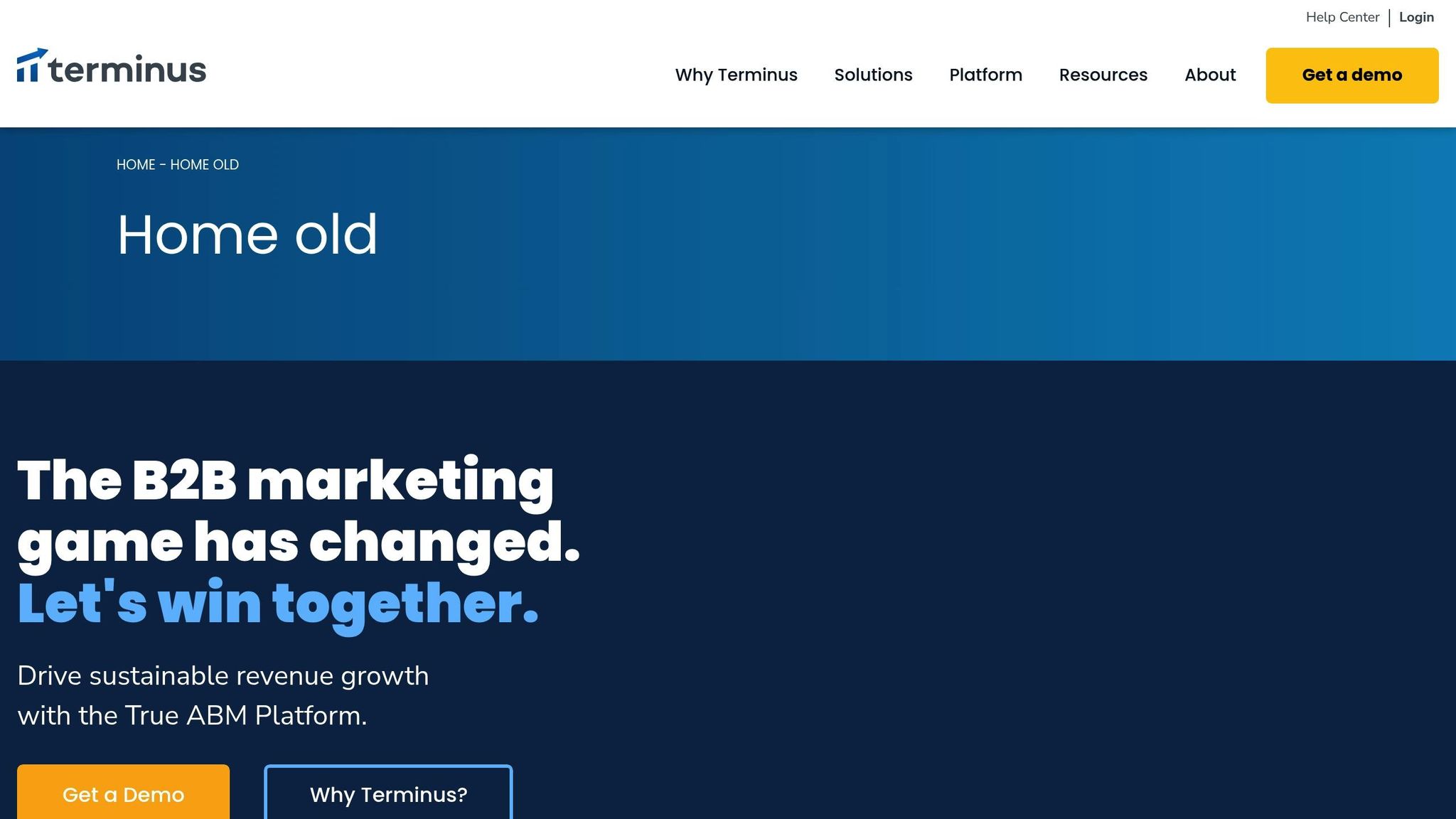
Terminus is an ABM platform designed to manage the entire customer lifecycle. Its full-funnel approach aligns sales and marketing efforts across multiple channels, making it a go-to solution for businesses aiming to unify their teams and strategies.
ABM-Specific Features: Account Targeting and Engagement Tracking
Terminus streamlines account targeting and engagement through features like ad automation, native intent data, conversion tracking, and its B2B Account Graph, which connects anonymous web activity to specific companies.
One standout feature is its Automated Account Discovery tool. This tool identifies untapped, high-fit accounts and sends weekly sales updates that highlight top targets based on anonymous digital behavior.
"We're designing a system that automatically ingests all that data, surfaces what's most relevant, and lets you set up rules to take action on it automatically", says Bryan Brown, Chief Product Officer at Terminus.
This level of automation and insight powers ABM campaigns that often see engagement rates double those of traditional campaigns.
Integration Capabilities with Sales and Marketing Tools
Terminus integrates with a wide array of third-party tools, ensuring smooth data sharing and consistent outreach across channels. It connects with platforms like HubSpot, Salesforce, Microsoft Dynamics 365, Slack, Salesloft, Google Analytics, and Marketo, allowing teams to work efficiently within their existing systems.
A prime example of its integration capabilities is the January 2021 partnership with Outreach. This integration enables marketing and sales teams to align their efforts by linking Outreach's prospects and sequences to Terminus's chat, email signature advertising, and website personalization features.
"It's our mission to help marketing and sales together drive full funnel account engagement", explains Tim Kopp, Terminus CEO.
This integration highlights Terminus's role as a bridge between sales and marketing, fostering collaboration and efficiency.
Collaboration Tools for Data Sharing and Campaign Tracking
Terminus enhances team collaboration by providing shared visibility into account engagement across various channels. Through its multi-channel approach, which includes display ads, email campaigns, and website visits, teams can sync their efforts, eliminate duplicate outreach, and ensure messaging stays consistent.
The platform’s campaign tracking tools also allow teams to monitor how accounts move through different stages of the customer lifecycle. This insight helps identify bottlenecks and enables teams to address them with targeted follow-ups or personalized content.
These features make Terminus a valuable solution for organizations looking to streamline their ABM efforts across departments.
Scalability for Small to Enterprise-Level ABM Efforts
Built to support mid-sized and enterprise companies, Terminus offers scalable multi-channel ABM capabilities that adapt to businesses as they grow. Its focus on the entire customer lifecycle - from acquisition to retention and expansion - makes it a comprehensive choice for organizations with evolving needs.
"Terminus differentiates itself by addressing the entire customer lifecycle, from acquisition to retention and expansion".
For companies seeking a robust ABM platform that grows alongside their business, Terminus delivers the infrastructure needed for long-term success.
8. Sendoso
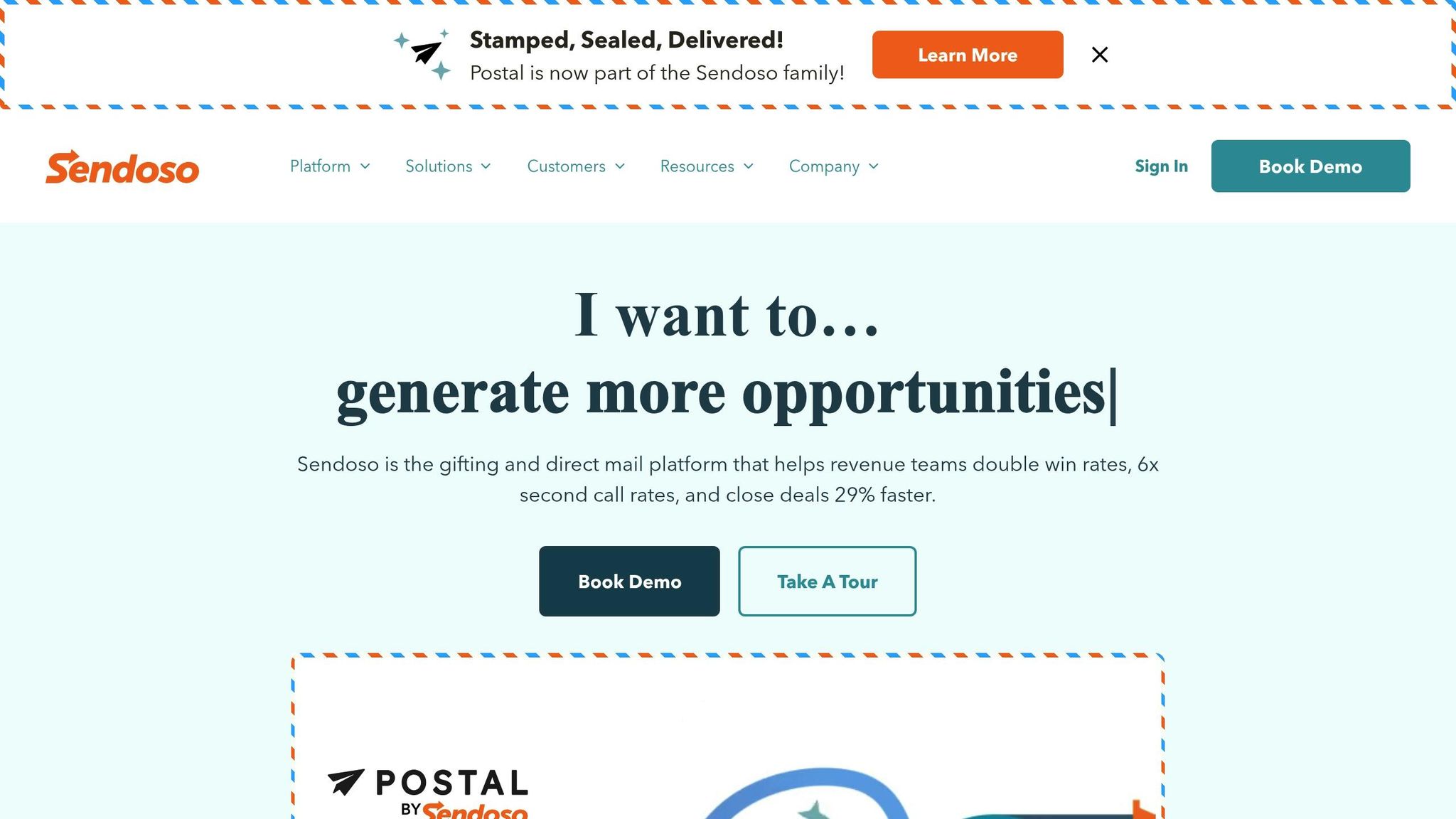
Sendoso takes ABM outreach to a whole new level by adding a personal, physical element to digital campaigns. This direct mail and gifting platform allows sales and marketing teams to cut through the digital noise with thoughtful, personalized gifts and handwritten notes that leave a lasting impression.
ABM-Specific Features: Personalization and Engagement Tracking
Sendoso shines with its ability to create tailored gifting strategies for different buyer personas within target accounts. Whether it's one-on-one or one-to-many gifting, the platform handles all the logistics of physical delivery. Plus, its built-in tracking and analytics provide clear insights into the return on investment (ROI) for gifting campaigns. Teams can track the entire process - from when a gift is sent to when it’s received - and even monitor eGift openings.
Campaigns using Sendoso’s approach have delivered impressive results: a 3X increase in meeting rates, a 6X boost in second call rates, a 2X jump in win rates, and an 84% response rate from C-suite executives compared to digital-only strategies. For instance, BetterCloud saw a staggering 529% increase in revenue influenced by direct mail campaigns powered by Sendoso.
"We've seen response rates and success with Sendoso like no other form of outreach", says Peter Tarrant, Account Based Marketer at Tipalti.
Seamless Integration with Existing Tools
Sendoso integrates with over 90 tools, ensuring it fits smoothly into your existing ABM workflows. It connects with leading ABM platforms like Terminus, 6Sense, Demandbase, Bombora, and RollWorks, allowing teams to trigger personalized gifts directly from their workflows. Additionally, it works with major CRM, sales engagement, and marketing automation tools such as Salesforce, Outreach, Salesloft, Marketo, HubSpot, and Eloqua. This means gifting campaigns can be automated based on account behavior or campaign milestones.
Gong leveraged these integrations to stand out in the competitive SaaS market, generating over 400 new opportunities with strategic gifting campaigns.
"And Sendoso allows us to cut through all of the SaaS noise", explains Russell Banzon, VP of Marketing at Gong.
These integrations ensure Sendoso becomes a natural part of your ABM strategy.
Collaboration and Campaign Visibility
Sendoso enhances teamwork by offering shared visibility into gifting campaign performance for both sales and marketing teams. Real-time updates on delivery status, engagement rates, and pipeline impact keep everyone aligned on campaign outcomes. Beyond simple delivery tracking, the platform lets teams see how gifting touchpoints influence the customer journey - from the first interaction to closing deals.
RollWorks saw notable improvements in their sales process with this collaborative approach. Their campaigns not only supported revenue goals but also shortened the sales cycle.
"When Sendoso is put into play we see a much shorter sales cycle. Direct mail works and it continues to work. And Sendoso takes it an extra mile, and contributes to our revenue goals time and time again", says Katie Dunn, Demand Generation Marketing Manager at RollWorks.
Scalable for Businesses of All Sizes
Sendoso’s features and integrations make it scalable for both small businesses and large enterprises. It transforms broad outreach into personalized, meaningful interactions, helping marketing teams build standout strategies that scale effortlessly. For global efforts, the platform offers international address validation and a wide range of gift options, delivering over 200% ROI on new revenue and boosting response rates by 4X.
Cradlepoint is a great example of this scalability. By incorporating Sendoso and using a tiered gifting strategy, the company achieved $2.36M in open opportunities, booked 50 meetings, maintained an 89% interaction/send rate, and influenced $530K in pipeline from just one campaign.
Sendoso offers three pricing tiers. The Essential plan includes two integrations and up to 1,500 annual gift sends. Larger plans offer advanced features like custom packaging and dedicated success management, with pricing tailored to your needs.
9. Demandbase
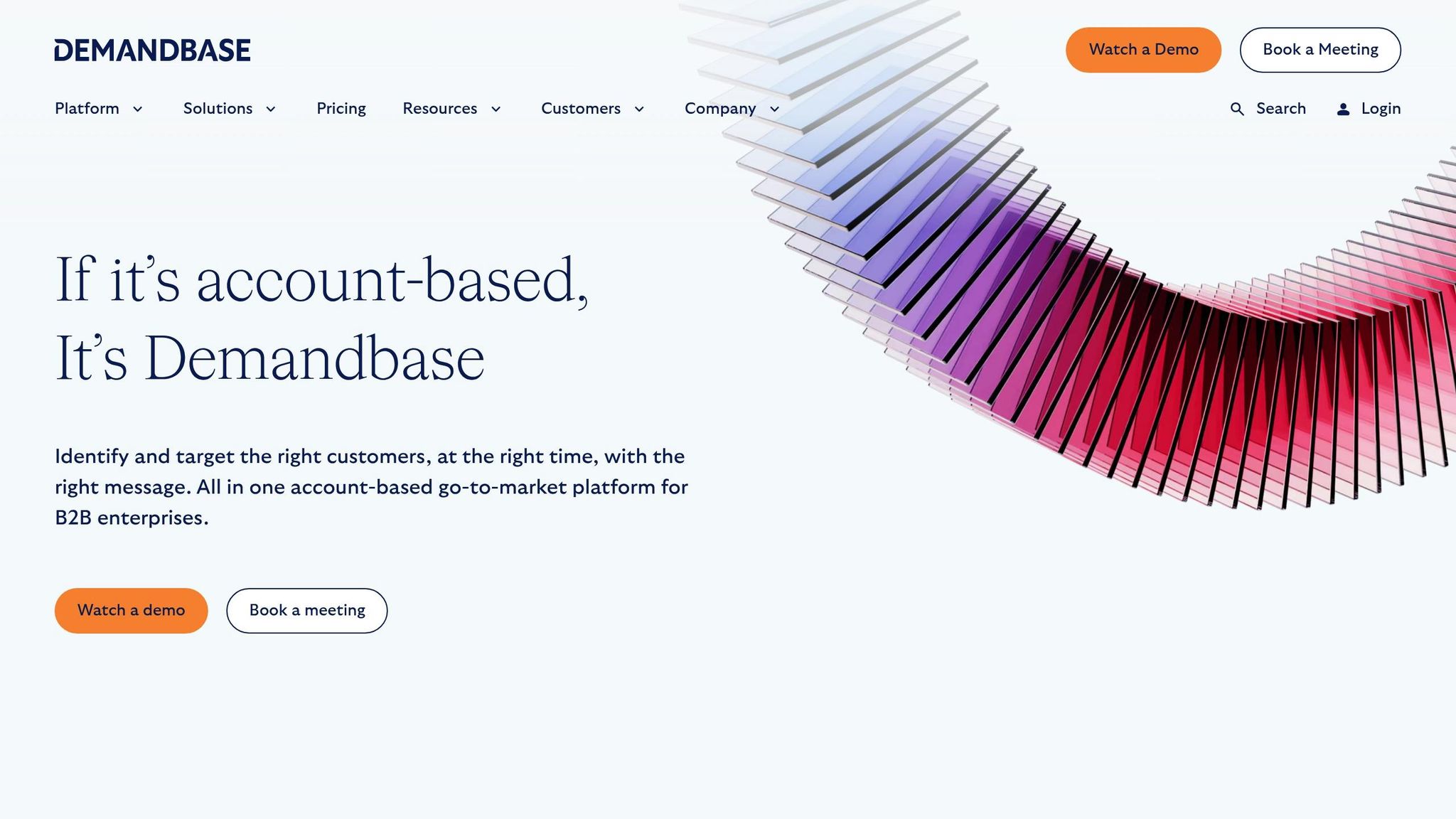
When it comes to tools that bridge the gap between ABM sales and marketing efforts, Demandbase stands out as a powerful option. This AI-driven platform helps sales and marketing teams pinpoint, target, and engage high-value accounts more effectively. Unlike many tools, Demandbase doesn’t just stop at account targeting - it dives deep into buyer behavior and intent, offering a wealth of insights to guide strategy.
ABM-Focused Features for Account Targeting and Engagement
At the heart of Demandbase is its Account Intelligence, which lays the groundwork for impactful ABM strategies. Using AI-powered qualification scores and pipeline prediction analytics, it identifies accounts that align with your ideal customer profile (ICP) and are actively in the market. This eliminates much of the guesswork. Its intent data capabilities track online search behavior and content consumption across first- and third-party sites, revealing which accounts are researching solutions - or even competitors.
One of its standout tools, Engagement Minutes, assigns a score to account activity by monitoring interactions across marketing channels, sales outreach, and web traffic. The platform also provides heatmaps that help prioritize engagement efforts across buying committees.
"Demandbase is a great tool to move your targeting from a one-to-many to a one-to-one and do some true ABM tactics... you can truly target the leads that your sales team is looking to get into, or even better, help them move through the pipeline by targeting your opportunity accounts."
– Michael R., Marketing Manager, Enterprise
The impact is clear: accounts approached with an ABM strategy saw a 53% close rate, compared to just 19% for traditional demand generation.
Seamless Integration with Sales and Marketing Tools
Demandbase shines in its ability to integrate with a wide range of tools, creating a unified system for sales and marketing teams. It connects with leading CRM platforms like Salesforce, HubSpot, and Microsoft Dynamics, as well as marketing automation tools like Marketo, Pardot, Eloqua, and HubSpot MAS. It also integrates with ad networks such as LinkedIn, Google, Facebook, and Adobe, along with sales tools like Gong, Outreach, and Slack. Additionally, it works with content marketing platforms like Uberflip and PathFactory, and direct mail solutions like Alyce, PFL, and Reachdesk.
Companies leveraging these integrations with AI-driven ABM strategies report a 30% increase in engagement rates.
"We've relied on Demandbase to help support our clients and their mission-critical needs, time and time again. In the industries we serve, time is our most precious asset and Demandbase helps us to achieve precise outcomes, faster."
– Jonathan Agoot, Director, Digital Strategy and Transformation, Ogilvy Health
Tools for Team Collaboration and Campaign Tracking
Demandbase also fosters collaboration between sales and marketing teams by providing a unified view of accounts. Its lead-to-account matching feature links both known individuals and anonymous visitors (via domain) to their respective accounts. Rich account profiles, which combine firmographic, technographic, and intent data, allow sales teams to zero in on accounts that meet their ICP and are ready to buy. Meanwhile, marketing teams can use the same data to design targeted campaigns and track their impact on the sales pipeline.
Jodi Lebow, Director of Marketing at Hexagon, highlighted how Demandbase transformed their processes:
"We couldn't really measure success before implementing Demandbase."
– Jodi Lebow, Director of Marketing, Hexagon
Scalable Solutions for ABM at Any Level
Demandbase is designed to scale with your ABM efforts, whether you’re targeting mid-market accounts or focusing on large, enterprise-level opportunities. Its AI capabilities enable personalized campaigns on a scale that would otherwise be resource-intensive. For instance, a mid-market strategy might involve sending intent-based messaging to 50 companies, while an enterprise approach could focus on highly customized campaigns for individual Fortune 500 accounts.
AI automation further streamlines this process, reducing the time needed for customization from three weeks to just two days, making it feasible to scale ABM efforts globally. Demandbase empowers businesses to tackle complex global accounts and deliver measurable ROI across multiple business units.
10. Engagio (now part of Demandbase)
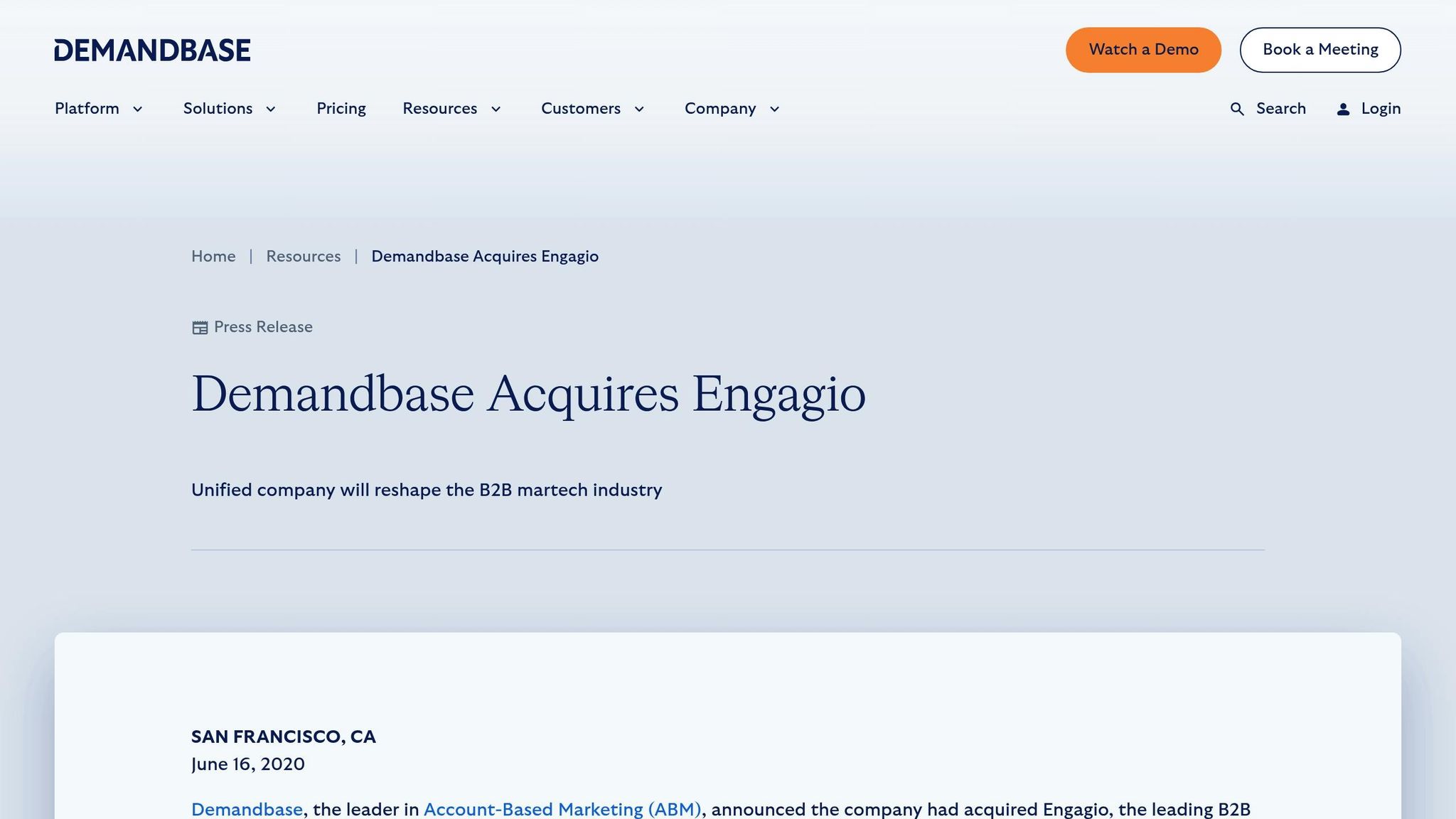
Engagio made a name for itself in the ABM space before its acquisition by Demandbase, specializing in tracking and managing account-based interactions across marketing and sales. Now integrated into Demandbase's platform, Engagio's contributions continue to shape ABM collaboration. Its tools and techniques complement the features offered by other platforms in the ABM ecosystem.
ABM-Specific Features for Account Targeting and Engagement Tracking
Engagio stood out for its advanced engagement tracking capabilities. It introduced engagement minute scoring, a system that quantified interactions across various touchpoints, offering insights into relationships at both individual and group levels. The platform’s account insights feature went beyond standard demographic data, delivering actionable intelligence on buying committees. It tracked how different stakeholders interacted with content, attended events, and engaged with sales efforts. Additionally, its sophisticated attribution models helped verify ROI and identified which activities advanced accounts through the buying journey.
Integration Capabilities with Sales and Marketing Tools
Prior to its acquisition, Engagio seamlessly integrated with Salesforce, enabling alignment between sales and marketing teams. Features like sales intelligence, automated playbooks, and CRM data enrichment helped streamline workflows. After becoming part of Demandbase, these functionalities evolved into Demandbase One, a unified platform combining ABM and marketing automation. This integration supports a wide range of sales and marketing tools, making it easier to implement scalable ABM strategies.
Scalability for Small to Enterprise-Level ABM Efforts
Engagio’s tiered approach to ABM provided solutions for businesses of all sizes. The platform allocated resources based on account value, offering three distinct tiers: Strategic ABM (one-to-one), Scale ABM (one-to-few), and Programmatic ABM (one-to-many).
- Strategic ABM targeted high-value accounts, often worth seven figures annually, with highly personalized campaigns and dedicated teams.
- Scale ABM catered to mid-market companies, focusing on groups of 5-15 high-value accounts with shared characteristics.
- Programmatic ABM was ideal for smaller businesses, enabling them to reach hundreds or even thousands of accounts through technology-driven personalization.
This tiered system acknowledged the unique needs of different business sizes. Enterprises benefited from long-term, personalized strategies involving multiple touchpoints, while smaller and mid-sized businesses could implement agile, scalable approaches for faster results. Research shows that ABM strategies often lead to higher ROI and improved client retention.
"In ABM, there is no fence." – Engagio
ABM’s effectiveness isn’t confined to specific industries or company sizes - it’s about crafting focused strategies that address the unique needs of target accounts.
Tool Comparison Table
Selecting the right ABM tool means aligning platform features with your specific needs. With 91% of organizations running ABM programs and 81% reporting a higher ROI compared to traditional marketing methods, the stakes for choosing the right tool are high. Below is a side-by-side comparison of key platforms, highlighting their features, integrations, pricing, best use cases, and user ratings.
| Tool | Key Features | Integration Options | Pricing Range | Best Use Cases | User Ratings |
|---|---|---|---|---|---|
| HubSpot Marketing Hub | CRM integration, analytics dashboards, automation workflows | Native Salesforce, robust analytics platform | Starting at $800/month (billed annually) | Small to mid-size businesses seeking an all-in-one solution | G2: 4.4/5, TrustRadius: 8.4/10 |
| Marketo (Adobe) | Advanced automation, lead scoring, personalization | Salesforce, Adobe Marketing Cloud, webinars, AdWords | Prime plan (quote required) | Enterprise-level marketing automation | Powerful but steeper learning curve |
| Salespanel | Visitor tracking, lead qualification, behavioral analytics | CRM synchronization, marketing automation platforms | Custom pricing | B2B companies focused on lead intelligence | Real-time account identification |
| LinkedIn Sales Navigator | Professional network targeting, InMail capabilities, lead recommendations | CRM integration, social selling tools | Core plan: $99.99/month | Social selling and professional networking | LinkedIn's native B2B database |
| Clearbit | Data enrichment, lead scoring, API integrations | CRM, marketing automation, analytics tools sync | Custom pricing | Data-driven personalization and enrichment | G2: 4.4/5, TrustRadius: 8.9/10 |
| Leadfeeder | Website visitor identification, lead qualification, Google Analytics integration | CRM platforms, marketing automation tools | Tiered subscription model | Website visitor conversion optimization | Real-time visitor intelligence |
| Terminus | Multi-channel advertising, account insights, attribution | Salesforce, HubSpot CRM integration | Enterprise pricing | Mid-market to enterprise ABM campaigns | G2: 4.5/5, TrustRadius: 8.3/10 |
| Sendoso | Direct mail automation, gifting campaigns, ROI tracking | CRM and marketing automation integration | Custom enterprise pricing | Physical touchpoint campaigns | Unique offline-to-online engagement |
| Demandbase | AI-powered targeting, personalization, account intelligence | Salesforce, Adobe Marketing Cloud | Enterprise-level pricing | Large-scale ABM orchestration | G2: 4.3/5, TrustRadius: 8.2/10 |
| Engagio (Demandbase) | Engagement scoring, account insights, attribution models | Salesforce, now part of Demandbase One | Integrated into Demandbase pricing | Engagement tracking and measurement | Advanced relationship mapping |
For smaller teams or businesses new to ABM, HubSpot and LinkedIn Sales Navigator offer user-friendly, scalable options. On the other hand, enterprise-level organizations may benefit more from platforms like Demandbase and Terminus, which provide advanced orchestration and integration capabilities.
Integration and functionality are key factors to consider. For instance, Terminus and Demandbase deliver seamless Salesforce integration, HubSpot offers native CRM functionality, and Clearbit stands out for its data enrichment capabilities across various platforms.
"Account-based marketing is a strategic approach that coordinates personalized marketing and sales efforts to open doors and deepen engagement at specific accounts."
- Jon Miller, former CMO at Demandbase
When narrowing down your options, focus on ROI, integration compatibility, scalability, and support quality. Start by identifying your business needs, test tools during pilot phases, and choose platforms that can grow alongside your ABM strategy.
Conclusion
Choosing the right ABM tool can make all the difference in aligning sales and marketing efforts. Businesses using ABM report a 171% increase in average annual contract value, which highlights just how important this decision is.
Start by defining your marketing objectives and working within a realistic budget. Keep in mind that the most expensive tool isn’t always the best fit. Look for platforms that excel in CRM integration, detailed reporting and analytics, high-quality targeting data, and personalized messaging. These features are essential for delivering measurable outcomes.
Your ABM tool should also integrate seamlessly with your current tech stack. A connected system creates a unified source of truth, which directly supports your broader sales and marketing strategies. This kind of integration boosts campaign efficiency and ensures smoother operations.
The right tool not only improves internal processes but also enhances external interactions. For instance, B2B buyers are 19% more likely to accept a connection request and 15% more likely to open a sales-oriented LinkedIn InMail when they’ve already engaged with your company’s marketing. This shows how the right tools can amplify your outreach efforts.
When exploring your options, consider resources like the Email Service Business Directory. Since email remains a cornerstone of ABM campaigns, having access to detailed comparisons of email platforms can help you make informed decisions and improve your strategy.
Finally, remember that the tool is just one part of the equation. Accurate data and a skilled team are what truly bring an ABM platform to life. Even the best tools need proper implementation and consistent optimization to deliver results. Start with a pilot program, evaluate the outcomes, and select platforms that can scale alongside your ABM goals.
FAQs
How can I choose the best ABM tool for my company's goals and budget?
How to Choose the Best ABM Tool for Your Business
Selecting the right ABM tool starts with defining your goals. Are you aiming to improve team collaboration, track campaign performance more effectively, or streamline data sharing? Knowing what you want to achieve will narrow down your options.
From there, think about practical factors like how easy the tool is to use, whether it can grow alongside your business, and how well it suits your team size. Scalability is especially important if you’re planning for future expansion.
Budget is another key consideration. Compare the features each tool offers against its cost, making sure it aligns with your technical needs and the complexity of your campaigns. The goal is to find a tool that fits both your strategy and finances, helping your ABM efforts deliver real results.
What integration features should an ABM tool have to help sales and marketing teams work together effectively?
When selecting an ABM tool, it's important to focus on CRM integration. This ensures smooth data sharing and provides a unified view of customer insights. Additionally, opt for tools with real-time collaboration features. These allow sales and marketing teams to access shared data simultaneously and take coordinated action. The result? Better team alignment, more accurate data, and easier campaign tracking - all key to achieving ABM success.
How can I evaluate the success and ROI of ABM tools in my marketing strategy?
To determine how well your ABM tools are performing and the return on investment they deliver, pay close attention to a few critical metrics: account engagement, conversion rates, and revenue impact. These measurements are essential for understanding how effectively your tools are generating results.
You should also track account penetration rates and analyze the outcomes of individual campaigns. These additional insights can reveal how your strategy is working and how your ABM efforts align with your broader business objectives.
